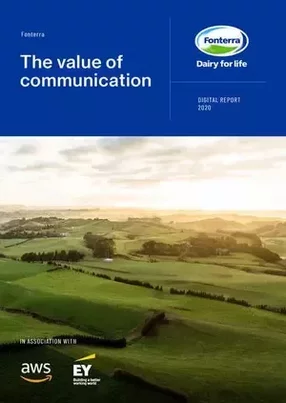Based out of Auckland, New Zealand, global dairy co-operative Fonterra exports products to over 140 countries, reaching one billion people every day. It employs approximately 20,000 people around the world and is owned by 10,000 New Zealand farmers and families, many of whose roots in the industry span generations.
Piers Shore has been the Chief Information Officer at Fonterra for over a year now. From life sciences, to heavy manufacturing to consumer products, he has worked across multiple marketing and IT roles that focus on international business and digital strategy and transformation. “The first thing you do as an incoming CIO is understand the state of play,” Shore explains. Effective communication across the business is at the core of Shore’s strategy for Fonterra. When he first joined, Shore and his team ran a company-wide IT survey, asking all employees to give feedback on the current IT tools and services available to them. Their answers provided Shore and his team with strategic focus areas, and a baseline against which they could measure future progress. “We had good response rates that indicated they really valued the IT services and tools that enable their jobs,” he continues, “but it also highlighted areas of improvement. We then articulated a very practical IT strategy that was aligned with the overarching business transformation. The IT strategy and business strategy should be complementary, not competitive.”
The main problem, according to Shore, was that Fonterra’s IT capabilities were “an inch deep and a mile wide.” He and his management team recommended an urgent transformation programme, focusing on three key areas. “We need to articulate IT in non-technical terms to ensure it is understandable to anyone, at any level, from any department, rebuilding our infrastructure and operations including a significant enhancement of our business partnerships, and improving our diversity and inclusion,” explains Shore.
He is a firm believer in building deep, long-lasting relationships with key suppliers and strategic partners. To this end, he has recently overseen a process to review and consolidate vendors across his Infrastructure, End User Compute, Security, and Service Delivery estate into a single, long-term strategic partnership with HCL. HCL Technologies will bring together Co-operative's IT infrastructure under one umbrella and will reinforce a digital foundation to support their transformation initiatives.
With the spread of COVID-19 now a reality for our people, communities and way of life, Fonterra’s new strategic partnership with HCL is more important than ever. Fonterra employees are now increasingly reliant on technology and mobility to do their work. The pandemic highlights the critical need for a rock-solid infrastructure at Fonterra.
This partnership will also extend HCL’s New Zealand presence to three offices within the country and will bring around 60 new jobs to the Waikato region, as the local support services for Fonterra employees will be based at its Hamilton Delivery centre.
Fonterra is committed to adding value not just to customers, but to its surrounding community. “By partnering with major tech firms like Microsoft, Sales Force, SAP and Amazon, it brings us much needed global technical expertise, which will also help the evolution of the technology ecosystem of New Zealand as a country,” Shore explains.
“It’s very important when you are on a transformation journey that you communicate,” says Shore. “Not just with your own team of global, highly-skilled IT professionals, but with stakeholders across the business. You can have an elegant, highly technical strategy but if people anywhere in the business, at any level, can’t articulate simply what your plan is, I would question the possibility of success.” Shore takes a “cascade approach”, regularly interacting with Fonterra’s executive management to ensure teams across the company are informed on the state of IT strategy and are able to seek assistance in areas pertinent to them. “It’s important to communicate on the basis of the value IT adds to your stakeholders. It will vary based on their area and their drives,” he continues. “Just talking tech may not resonate with everyone, but application to business areas will.”
It is important to Shore that he is visible across the company as the CIO. This includes visiting manufacturing and R&D sites to understand how technology is used on a day-to-day basis and hearing directly from people how IT could be leveraged further. He also visited the company IT helpdesk and listened into calls to understand what people struggle with. Additionally, Shore runs regular CIO dialogue sessions, both virtual and face-to-face, with the global IT team. The feedback and suggestions that come from these interactions directly impact Fonterra’s IT strategy. “It’s important that you have the integrity to reach out to employees in a transparent fashion and ask them to benchmark your performance,” says Shore. “At the end of the day, we’re all one company and want what’s best. It’s vitally important we work as a team.” Shore’s focus on visibility extends to how Fonterra presents to the world; he maintains positive relationships with senior management and CEO’s of major global tech companies to ensure Fonterra has access to world-class innovative minds.
The global dairy co-operative relies on developing strong partnerships to ensure it is participating in the global tech economy. “In the life sciences industry, it is particularly important that you partner with selected strategic entities that progress your pipeline,” explains Shore. “I wanted to take the same approach with Fonterra.” By connecting with a tech giant like Microsoft, SAP and Amazon, Fonterra ensures its data strategy is optimised. Global brands also provide expertise around cutting-edge processes. EY has been a key partner in Fonterra’s integration of a Lean Six Sigma methodology into IT, training green belts, and assisting in framework implementation. “Having an internationally recognised standard that our IT employees can aspire to and get trained upon is phenomenal for development,” explains Shore. “We’ve achieved some significant results, not only absolute financial savings, but time savings and significant productivity enhancement.” Projects pioneered through a Lean Six Sigma framework have resulted in Fonterra reducing the number of unallocated laptops in the warehouse by around 40% and reducing the average time to approve project invoices by 70%. Shore hopes to dramatically increase the usage of Six Sigma in IT to drive enhanced productivity and efficiency across the business.
Fonterra received a 2019 SAP Innovation Award for a joint IT-HR project called Project App. Alongside SAP, it sought a way to improve the visibility of projects and initiatives at the company so people with the right skill sets could get involved. “The solution was to build an online tool that used SAP cloud in which projects could be registered and the skill sets advertised,” explains Shore. “It’s a simple idea: we’re leveraging technology to match opportunities with people. It’s at the core of what we’re trying to do here: rebuilding our baseline infrastructure and foundation. Once you have that, it becomes something you can leverage to drive future transformation.”
In summary, Shore says “I am extremely excited about the role IT can play in helping to support the new Fonterra strategy. We are part of the business and we wish to leverage technology to drive great value to our stakeholders and Fonterra customers around the world”.






- Coforge: Arming Financial Firms with the Tools to InnovateDigital Transformation
- Coforge: Arming Financial Firms with the Tools to InnovateDigital Transformation
- MWC24: Harnessing AI to Modernise Telcos with Tech MahindraDigital Transformation
- Big Ass Fans' Journey Through Digital TransformationDigital Transformation

